-
Countries
-
Data and Analysis
-
Special Focus
-
Crisis Responses
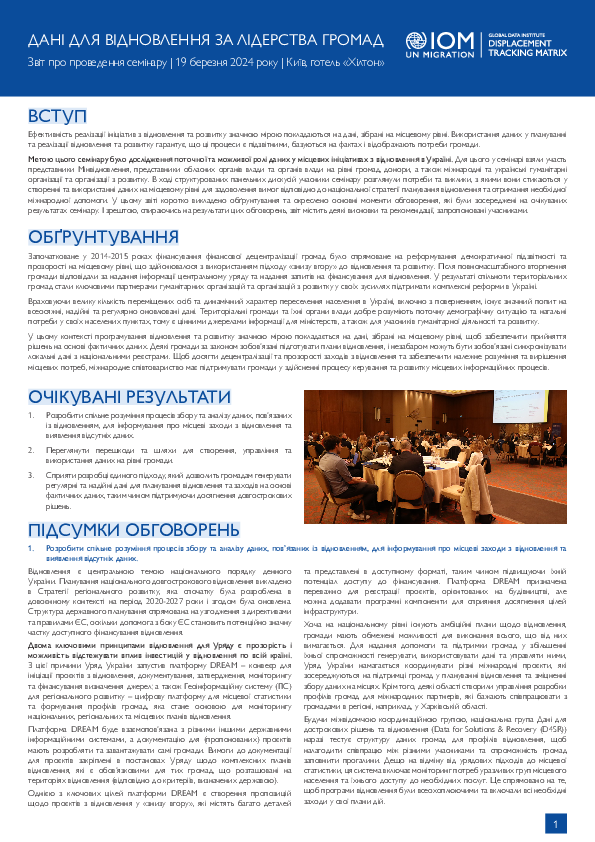
Contact
DTM Ukraine, dtmukraine@iom.int
Language
English
Location
Ukraine
Snapshot Date
Mar 19 2024
Activity
- Other
Ефективні ініціативи з відновлення та розвитку значною мірою спираються на дані, зібрані на місцевому рівні. Використання даних у плануванні та реалізації заходів з відновлення та розвитку гарантує, що ці процеси будуть підзвітними, фактологічно обґрунтованими та відображатимуть потреби громади.
Цей семінар мав на меті дослідити поточну та можливу роль даних у місцевих ініціативах з відновлення в Україні. Для цього в семінарі взяли участь представники Міністерства з питань відновлення, обласної та місцевої влади, донори, а також міжнародні та українські гуманітарні організації та організації, що займаються питаннями розвитку. Під час серії структурованих панельних дискусій учасники семінару розглянули потреби та виклики, з якими стикаються при створенні та використанні даних на місцевому рівні, щоб задовольнити вимоги відповідно до національної стратегії планування відновлення та залучити необхідну міжнародну допомогу.
У цьому звіті узагальнено обґрунтування та викладено основні моменти дискусій, які були зосереджені на очікуваних результатах семінару. Нарешті, на основі цих обговорень у звіті представлені деякі висновки та рекомендації, запропоновані учасниками.
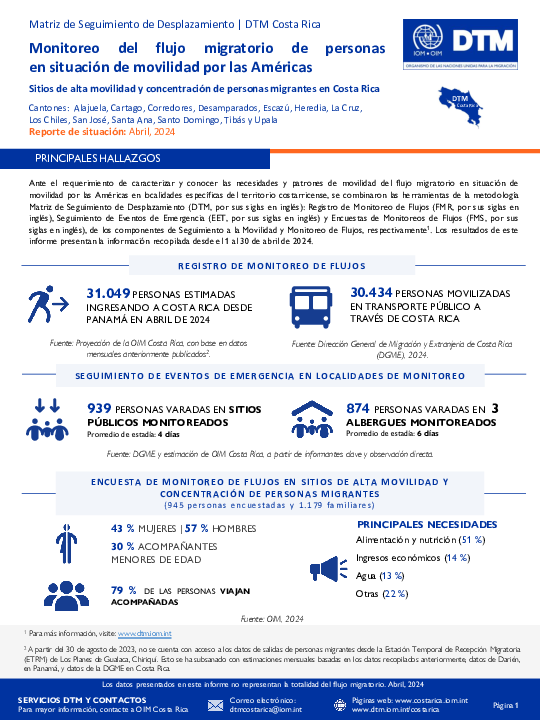
Contact
Angélica Madrigal amadrigal@iom.int
Language
English
Location
Costa Rica
Period Covered
Apr 01 2024
Apr 30 2024
Activity
- Survey
- Registration
- Flow Monitoring
Cantones: Alajuela, Alajuelita, Cartago, Desamparados, Escazú, Corredores, Heredia, Los Chiles, San Carlos, San José, Santa Ana, Santo Domingo, Tibás
Costa Rica, al igual que los demás países de la región centroamericana, se ha caracterizado por ser un corredor migratorio para personas que transitan de manera terrestre desde el sur hasta el norte de América y que tienen como destino los países del norte del continente. Este flujo en situación de movilidad por las Américas se encuentra compuesto principalmente por personas de la República Bolivariana de Venezuela, Cuba, Haití, Ecuador, así como personas provenientes de otros países de Suramérica, África y Asia.
Según estimaciones de la OIM Costa Rica, durante abril ingresaron al país 31.049 personas, un promedio aproximado de 1.035 personas por día y estimando una disminución de un 14% con respecto a marzo de 2024. Además, se identificaron 874 personas varadas en los albergues monitoreados y 939 personas varadas en los sitios públicos visitados.
Contact
DTM Yemen, iomyemendtm@iom.int
Location
Yemen
Activity
- Mobility Tracking
- Event Tracking
Period Covered
May 12 2024 -May 18 2024
From 1 January to 18 May 2024, IOM Yemen DTM tracked 1,300 households (HH) (7,800 Individuals) who experienced displacement at least once .
Between 12 and 18 May 2024, IOM Yemen DTM tracked 48 households (288 individuals) displaced at least once. The majority of people moved into/within the following governorates and districts:
- Ma’rib (21 HHs) – Ma’rib City (15 HHs), Ma’rib (6 HHs) districts. Most displacements in the governorate originated from Al Hodeidah and Ta’iz.
- Ta’iz (20 HHs) – Jabal Habashi (15 HHs), Mawza (3 HHs), Al Misrakh (2 HHs) districts. Most displacements in the governorate were internal.
- Hadramawt (5 HHs) – Al Mukalla City (5 HHs) district. All displacements in the governorate originated from Al Hodeidah.
The majority of people moved from the following governorates and districts:
- Ta’iz (22 HHs) – Jabal Habashi (16 HHs), Mawza (3 HHs), Hayfan (1 HH) districts.
- Al Hodeidah (13 HHs) – Bajil (6 HHs), As Sukhnah (5 HHs), Jabal Ras (1 HH) districts.
- Ma’rib (3 HHs) – Majzar (2 HHs), Al Jubah (1 HH) districts.
Population Groups
IDPs
Returnee (Previously Internally Displaced)
Survey Methodology
Unit of Analysis Or Observation
Admin Area 2
Household
Type of Survey or Assessment
Household
Key Informant
Keywords
Geographical Scope Partial Coverage
Administrative boundaries with available data
The current dataset covers the following administrative boundaries
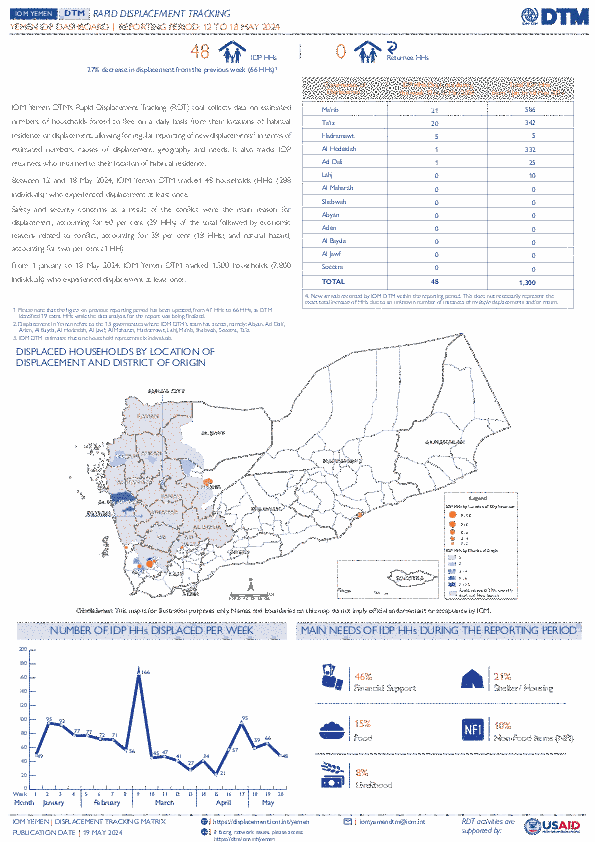
Contact
DTM Yemen, iomyemendtm@iom.int
Language
English
Location
Yemen
Period Covered
May 12 2024
May 18 2024
Activity
- Mobility Tracking
- Event Tracking
IOM Yemen DTM’s Rapid Displacement Tracking (RDT) tool collects data on estimated numbers of households forced to flee on a daily basis from their locations of origin or displacement, allowing for regular reporting of new displacements in terms of estimated numbers, geography, and needs. It also tracks returnees who returned to their location of origin.
From 1 January to 18 May 2024, IOM Yemen DTM tracked 1,300 households (HH) (7,800 Individuals) who experienced displacement at least once .
Between 12 and 18 May 2024, IOM Yemen DTM tracked 48 households (288 individuals) displaced at least once. The majority of people moved into/within the following governorates and districts:
- Ma’rib (21 HHs) – Ma’rib City (15 HHs), Ma’rib (6 HHs) districts. Most displacements in the governorate originated from Al Hodeidah and Ta’iz.
- Ta’iz (20 HHs) – Jabal Habashi (15 HHs), Mawza (3 HHs), Al Misrakh (2 HHs) districts. Most displacements in the governorate were internal.
- Hadramawt (5 HHs) – Al Mukalla City (5 HHs) district. All displacements in the governorate originated from Al Hodeidah.
The majority of people moved from the following governorates and districts:
- Ta’iz (22 HHs) – Jabal Habashi (16 HHs), Mawza (3 HHs), Hayfan (1 HH) districts.
- Al Hodeidah (13 HHs) – Bajil (6 HHs), As Sukhnah (5 HHs), Jabal Ras (1 HH) districts.
- Ma’rib (3 HHs) – Majzar (2 HHs), Al Jubah (1 HH) districts.
IOM identified 19 additional households displaced in the previous reporting period, which covered 05 - 11 May 2024, in the governorates of Ma’rib (7 HHs), Al Hodeidah (6 HHs), and Ta’iz (6 HHs). These figures have been added to the cumulative displacement total recorded since the beginning of the year.
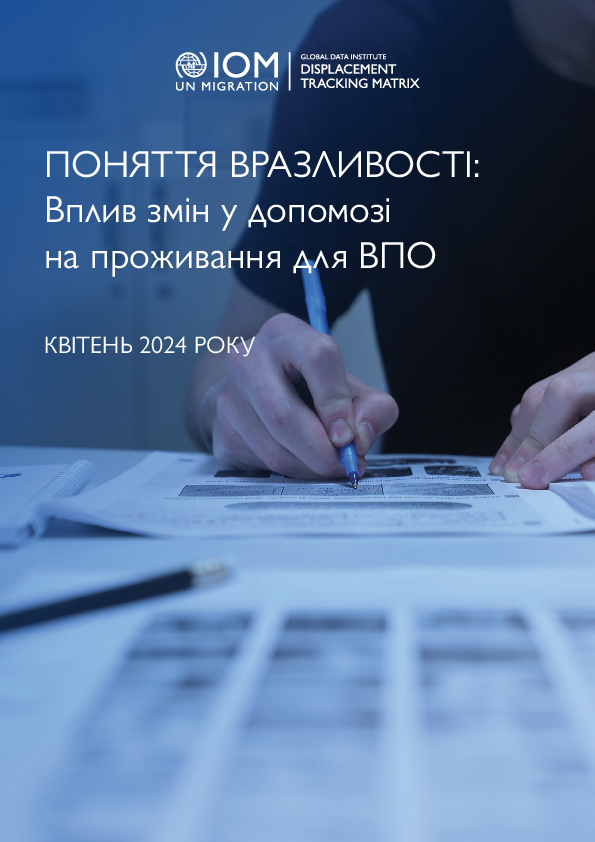
Contact
DTM Ukraine, dtmukraine@iom.int
Language
English
Location
Ukraine
Snapshot Date
Mar 01 2024
Activity
- Other
Зміни до критеріїв отримання допомоги, які набули чинності в березні 2024 року, обмежили доступ до допомоги на проживання ВПО на основі певного набору профілів соціально-економічної вразливості. Запровадження додаткових критеріїв має на меті забезпечити, щоб соціальна допомога в Україні була здатна підтримати найбільш вразливі верстви населення, як серед переміщених осіб, так і серед населення в цілому. Однак це збільшує ризик виключення деяких вразливих осіб, які можуть втратити доступ до допомоги на проживання ВПО за новими критеріями. Таке скорочення щомісячного доходу домогосподарств може вплинути на здатність вразливих домогосподарств задовольняти свої базові потреби та відновлювати своє життя.
Мета цього тематичного нарису — надати огляд оціночної частки та кількості ВПО, які все ще можуть мати право на отримання грошової допомоги ВПО за новими критеріями. Використовуючи наявні вторинні дані, цей тематичний нарис має на меті надати орієнтовний огляд частки та кількості ВПО, які більше не матимуть права на отримання допомоги, незважаючи на те, що вони є вразливими до скорочення доходів домогосподарств, яке може вплинути на їхню здатність задовольняти базові потреби. Цей документ має на меті інформувати та підтримувати адвокаційну діяльність і розробку програм гуманітарних партнерів на додаток до нової схеми виплати грошової допомоги ВПО.
Примітка: Ця записка була переглянута 26 квітня 2024 року, щоб відобразити останні зміни до Постанови 332, які набули чинності 22 березня. Очікуваний вплив тепер відображає найновіші критерії для отримання права на отримання грошової допомоги на проживання для ВПО
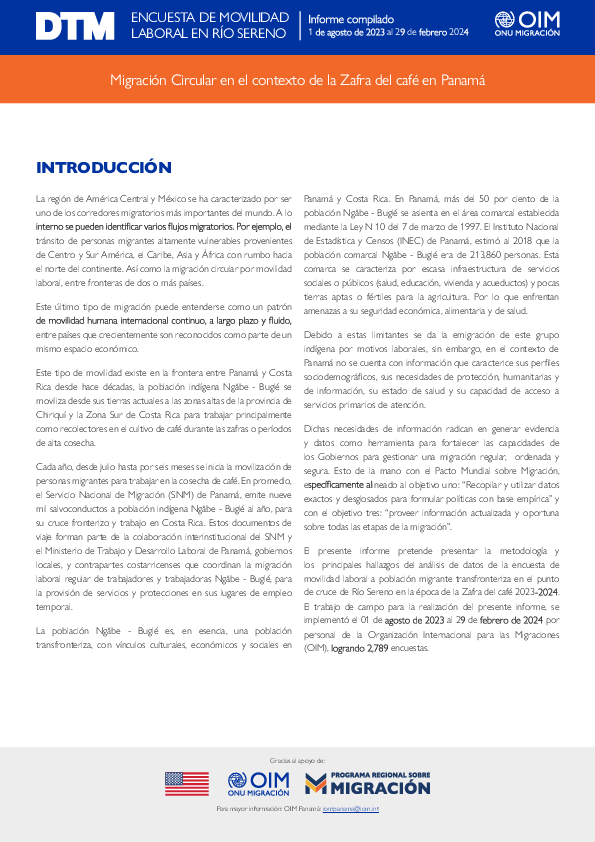
Contact
iompanama@iom.int
Language
Spanish
Location
Panama
Period Covered
Aug 01 2023
Feb 29 2024
Activity
- Survey
a región de América Central y México se ha caracterizado por ser uno de los corredores migratorios más importantes del mundo. A lo interno se pueden identificar varios flujos migratorios. Por ejemplo, el tránsito de personas migrantes altamente vulnerables provenientes de Centro y Sur América, el Caribe, Asia y África con rumbo hacia el norte del continente. Así como la migración circular por movilidad laboral, entre fronteras de dos o más países.
Este último tipo de migración puede entenderse como un patrón de movilidad humana internacional continuo, a largo plazo y fluido, entre países que crecientemente son reconocidos como parte de un mismo espacio económico.
Este tipo de movilidad existe en la frontera entre Panamá y Costa Rica desde hace décadas, la población indígena Ngäbe - Buglé se moviliza desde sus tierras actuales a las zonas altas de la provincia de Chiriquí y la Zona Sur de Costa Rica para trabajar principalmente como recolectores en el cultivo de café durante las zafras o períodos de alta cosecha.
Cada año, desde julio hasta por seis meses se inicia la movilización de personas migrantes para trabajar en la cosecha de café. En promedio, el Servicio Nacional de Migración (SNM) de Panamá, emite nueve mil salvoconductos a población indígena Ngäbe - Buglé al año, para su cruce fronterizo y trabajo en Costa Rica. Estos documentos de viaje forman parte de la colaboración interinstitucional del SNM y el Ministerio de Trabajo y Desarrollo Laboral de Panamá, gobiernos locales, y contrapartes costarricenses que coordinan la migración laboral regular de trabajadores y trabajadoras Ngäbe - Buglé, para la provisión de servicios y protecciones en sus lugares de empleo temporal.

Contact
iomnigeriadtm@iom.int
Language
English
Location
Nigeria
Period Covered
May 06 2024
May 12 2024
Activity
- Other
On 7 May 2024, armed bandits attacked Sakajiki community in Kaura Namoda LGA, Zamfara State. The incident led to three fatalities and four injuries, affecting 219 homes and 1,097 individuals. Among the affected were 614 children, 259 women, and 224 men. The displaced population moved to neighboring communities within Kaura Namoda LGA, including Arewa, Shiyar Nafiu, and Sabon gari. The attack resulted in the destruction or severe damage of 40 shelters and the loss of many possessions of households.
Of all the needs identified, food and non-food items (NFIs) were the most prevalent. Other needs included security, shelter, and health services.
Following these events, DTM (Displacement Tracking Matrix) field staff conducted rapid assessments to inform the humanitarian community and Government/partners, and to enable a targeted response.
Nigeria’s north-central and north-west zones are afflicted with a multi-dimensional crisis. Long-standing tensions between ethnic and religious groups often result in attacks and banditry or hirabah. These attacks involve kidnapping and grand larceny along the major highways by criminal groups. During the past years, the crisis has intensified and has resulted in widespread displacements across the north-central and north-western regions.

Contact
DTM South Sudan, SouthSudanDTM@iom.int
Language
English
Location
South Sudan
Period Covered
Apr 01 2024
Apr 30 2024
Activity
- Registration
- Biometric Registration
Between 1 and 30 April 2024, IOM’s Displacement Tracking Matrix (DTM) interviewed 1,106 households representing 7,810 household members to assess the beneficiary satisfaction among service-receiving IDPs during distributions in Bentiu IDP Camp.
Contact
dtmlebanon@iom.int
Location
Lebanon
Activity
- Mobility Tracking
- Baseline Assessment
Period Covered
Oct 10 2023 -Mar 14 2024
Since October 8 there has been an increase in cross-border incidents between Israel and Lebanon, resulting in the displacement of people both within the South and elsewhere within the country. Since October 10, the Displacement Tracking Matrix (DTM) has been conducting the daily monitoring of population movements. The objective of the exercise is to inform preparedness and response planning.
Population Groups
IDPs
Survey Methodology
Unit of Analysis Or Observation
Admin Area 2
Admin Area 3
Household
Individual
Type of Survey or Assessment
Key Informant
Keywords
Geographical Scope Full Coverage
Administrative boundaries with available data
The current dataset covers the following administrative boundaries
May 16 2024
Print